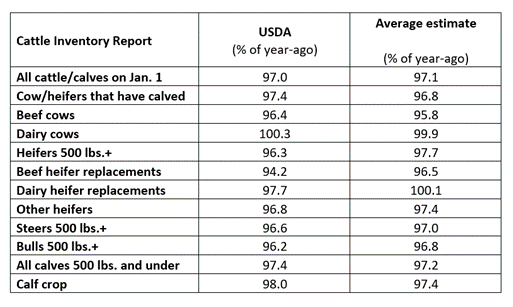U.S. Cattle Herd Smallest in Eight Years

America’s cattle inventory totaled 89.3 million head as of Jan. 1, 2023, according to USDA NASS. The total is 3% fewer than the 92.1 million a year ago.
NASS’ estimate for all cows and heifers that calved was 38.3 million, down 3% from 2022.
After sending 13.1% more beef cows to slaughter last year, the Jan. 1 inventory of beef cows was 28.9 million, down 4% from a year ago and matched the general consensus that the beef cow number would decline by a million head or more. The actual number was a decline of 1.065 million head. Milk cows at 9.4 million were slightly higher than last year.

The drought has played a huge role in the reduction of herds across the country, with Oklahoma showing the largest total inventory decline among top cattle states with an 11% decline. Oklahoma also experienced a 7% decline in beef cow inventories, which, along with Kansas, represents the largest percentage cow herd decline.
All heifers 500 pounds and over as of Jan. 1, 2023, totaled 19.2 million head, 4% below the 19.9 million head on Jan. 1, 2022. Beef replacement heifers, at 5.16 million head, were down 6% from a year ago. Milk replacement heifers, at 4.34 million head, were down 2% from the previous year. Other heifers, at 9.67 million head, were 3% below a year earlier.
Steers weighing 500 pounds and over as of Jan. 1, 2023, totaled 16.1 million head, down 3% from Jan. 1, 2022. Bulls weighing 500 pounds and over as of Jan. 1, 2023, totaled 2.03 million head, down 4% from Jan. 1, 2022.
Calves under 500 pounds as of Jan. 1, 2023, totaled 13.6 million head, down 3% from Jan. 1, 2022.
Cattle and calves on feed for the slaughter market in the United States for all feedlots totaled 14.2 million head on Jan. 1, 2023. The inventory is down 4% from the Jan. 1, 2022, total of 14.7 million head. Cattle on feed in feedlots with capacity of 1,000 or more head accounted for 82.5% of the total cattle on feed on Jan. 1, 2023, up 1% from the previous year. The combined total of calves under 500 pounds and other heifers and steers over 500 pounds (outside of feedlots) at 25.3 million head, was 3% below Jan. 1, 2022.
Calf Crop Declines
The 2022 calf crop in the United States was estimated at 34.5 million head, down 2% from the previous year. Calves born during the first half of 2022 were estimated at 25.3 million head, down 2% from the first half of 2021. Calves born during the second half of 2022 were estimated at 9.16 million head, 27% of the total 2022 calf crop.
Revisions
All inventory and calf crop estimates for July 1, 2021, Jan. 1, 2022, and July 1, 2022, were reviewed using calf crop, official slaughter, import and export data, and the relationship of new survey information to the prior surveys. Based on the findings of this review, Jan. 1, 2022, all cattle and calves increased by 0.2% and 2021 calf crop increased by 0.2%.
July 1, 2022, all cattle and calves decreased by 0.2% and 2022 calf crop decreased by 0.4%.







